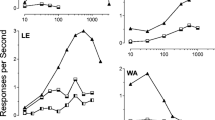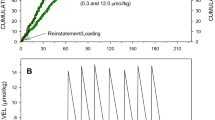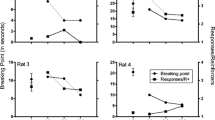Abstract
Rhesus monkeys were trained to emit 20 or 30 consecutive responses on one lever following an IM injection of pentobarbital (10 or 18 mg/kg) and the same number of consecutive responses on another lever following an injection of saline. The required number of correct consecutive responses in both cases resulted in food delivery. When responding was reliably under the control of the presession injection, the ability of a variety of other compounds to produce pentobarbital-appropriate responding was examined. Diazepam, clobazam, methohexital, pentobarbital, and phenobarbital, given 10 or 20 min before the session, produced dose-related pentobarbital-appropriate responding in each monkey. Ethylketazocine and dextromethorphan produced responding primarily on the saline-appropriate lever, whereas codeine, cyclazocine, dextrorphan and ketamine resulted in responding that was, on the average, intermediate between that appropriate for pentobarbital and that appropriate for saline. When tested at various times after their injection, methohexital (3.2 mg/kg) and pentobarbital (10 mg/kg) produced pentobarbital-appropriate responding within 10 min. Barbital (56 mg/kg) resulted in pentobarbital-appropriate responding only if at least 1 h intervened between the injection and the experimental session. The discriminative effects of methohexital, pentobarbital, and barbital lasted approximately 20–60, 120–240, and 480–720 min, respectively. The time-course of the discriminative stimulus effects of barbiturates in the rhesus monkey appears to parallel closely other pharmacological actions of these compounds.
Similar content being viewed by others
References
Barry H III (1974) Classification of drugs according to their discriminable effects in rats. Fed Proc 33:1814–1824
Barry H III, Krimmer EC (1977) Discriminable stimuli produced by alcohol and other CNS depressants. In: Lal H (ed) Discriminative stimulus properties of drugs. Plenum Press, New York, p 73
Barry H III, Krimmer EC (1978a) Pharmacology of discriminative drug stimuli. In: Ho BT, Richards DW III, Chute DL (eds) Drug discrimination and state dependent learning. Academic Press, New York, p 3
Barry H III, Krimmer EC (1978b) Similarities and differences in discriminative stimulus effects of chlordiazepoxide, pentobarbital, ethanol, and other sedatives. In: Colpaert FC, Rosecrans JA (eds) Stimulus properties of drugs: Ten years of progress. Elsevier/North Holland Biomedical Press, Amsterdam, p 31
Breimer DD (1976) Pharmacokinetics of methohexitone following intravenous infusion in humans. Br J Anaesth 48:643–649
Colpaert FC, Desmedt LKC, Janssen PAJ (1976) Discriminative stimulus properties of benzodiazepines, barbiturates and pharmacologically related drugs; relation to some intrinsic and anticonvulsant effects. Eur J Pharmacol 37:113–123
Hein DW, Young AM, Herling S, Woods JH (1981) Pharmacological analysis of the discriminative stimulus characteristics of ethylketazocine in the rhesus monkey. J Pharmacol Exp Ther 218:7–15
Herling S, Coale EH Jr, Hein DW, Winger G, Woods JH (1981) Similarity of the discriminative stimulus effects of ketamine, cyclazocine, and dextrorphan in the pigeon. Psychopharmacology 73:286–291
Herling S, Valentino RJ, Winger G (1980) Discriminative stimulus effects of pentobarbital in pigeons. Psychopharmacology 71:21–28
Holtzman SG (1980) Phencyclidine-like discriminative effects of opioids in the rat. J Pharmacol Exp Ther 214:614–619
Jarbe TUC (1976) Characteristics of pentobarbital discrimination in the gerbil: Transfer and antagonism. Psychopharmacology 49:33–40
Jarbe TUC, Ohlin GC (1979) Discriminative effects of combination of Δ9-tetrahydrocannabinol and pentobarbital in pigeons. Psychopharmacology 63:233–239
Jasinski DR (1977) Assessment of the abuse potentiality of morphinelike drugs (Methods used in man). In: Martin WR (ed) Drug addiction I: Morphine, sedative/hypnotic and alcohol dependence (Handbook of Experimental Pharmacology, vol 45/I). Springer, Berlin Heidelberg New York, p 197
Johansson JO, Jarbe TUC (1975) Antagonism of pentobarbital induced discrimination in the gerbil. Psychopharmacologia 41:225–228
Krimmer EC (1974) Drugs as discriminative stimuli. Dissertation Abst Internat 35:4572-B
Krimmer EC, Barry H III (1979) Pentobarbital and chlordiazepoxide differentiated from each other and from nondrug. Comm Psychopharmacol 3:93–99
Leberer MR, Fowler SC (1977) Drug discrimination and generalization in pigeons. Pharmacol Biochem Behav 7:483–486
Overton DA (1966) State-dependent learning produced by depressant and atropine-like drugs. Psychopharmacologia 10:6–31
Overton DA (1975) A comparison of the discriminable CNS effects of ketamine, phencyclidine, and pentobarbital. Arch Int Pharmacodyn Ther 215:180–189
Sharpless SK (1970) Hypnotics and sedatives. I: The barbiturates. In: Goodman LS, Gilman A (eds) The pharmacological basis of therapeutics (Fourth edition). MacMillan Publishing Co, New York, p 98
Trost JG, Ferraro DP (1974) Discrimination and generalization of drug stimuli in monkeys. In: Singh JM, Lal H (eds) Drug addiction, vol 3: Neurobiology and influences on behavior. Stratton, New York, p 223
Winger G, Stitzer M, Woods JH (1975) Barbiturate-reinforced responding in rhesus monkeys: dose comparisons of compounds with different durations of action. J Pharmacol Exp Ther 195:505–514
Witkin JM, Carter RB, Dykstra LA (1980) Discriminative stimulus properties of d-amphetamine-pentobarbital combinations. Psychopharmacology 68:269–276
Author information
Authors and Affiliations
Rights and permissions
About this article
Cite this article
Winger, G., Herling, S. Discriminative stimulus effects of pentobarbital in rhesus monkeys: Tests of stimulus generalization and duration of action. Psychopharmacology 76, 172–176 (1982). https://doi.org/10.1007/BF00435273
Received:
Accepted:
Issue Date:
DOI: https://doi.org/10.1007/BF00435273




